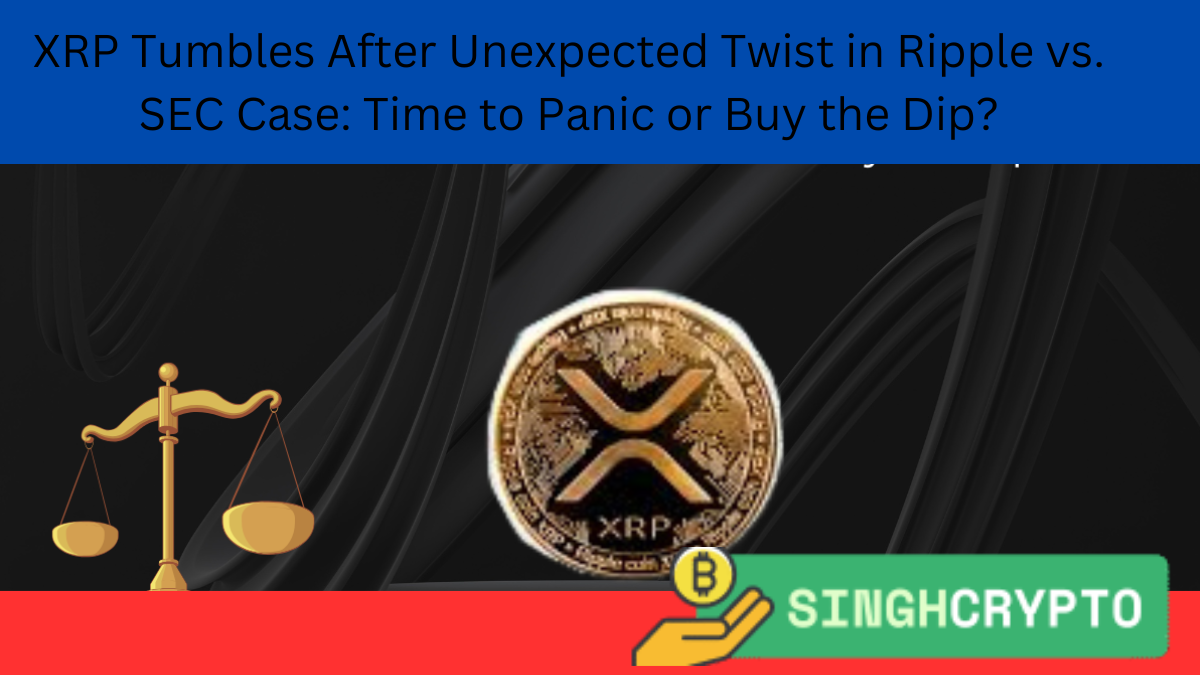ust days after XRP flirted with overtaking Tether as the third-largest cryptocurrency by market cap, the digital asset has taken a sharp turn south. By midday Thursday, XRP began to lose steam, and by early Friday, it had fallen roughly 4%, trading around $2.42 at the time of writing.
This sudden drop wasn’t just market noise. It stemmed from an unexpected development in the long-standing legal battle between Ripple—the company behind XRP—and the U.S. Securities and Exchange Commission (SEC). While other major cryptocurrencies are holding steady or edging higher, XRP is underperforming, casting a shadow over what was otherwise a promising uptrend.
A Legal Setback Rattles XRP Investors
For many in the crypto community, there was a growing sense of optimism that Ripple’s ongoing case with the SEC was finally nearing a resolution. Especially with the SEC now under new leadership believed to be more crypto-friendly than the previous administration led by Gary Gensler, some hoped for a fast-track settlement.
But hopes were dashed this week when Judge Analisa Torres rejected a joint motion submitted on May 8 by both Ripple and the SEC. The motion sought a “guidance order” that would essentially lift a 2024 injunction preventing Ripple from offering or selling XRP as an unregistered security. The motion also requested that Ripple’s civil penalty be slashed from $125 million to $25 million.
However, Judge Torres ruled that the proposed order would be “procedurally improper,” as neither party had filed the correct procedural motions. Legal analysts and investors alike were caught off guard by the judge’s rigid stance—especially since the SEC’s current leadership was expected to facilitate a smoother, more crypto-friendly outcome.
Attorney James K. Filan, who has closely followed the case, shared the update on X (formerly Twitter), sparking immediate backlash and uncertainty in the market.
This decision implies that a final verdict in the Ripple vs. SEC case may take longer than anticipated. And that delay carries consequences—notably for those holding out hope for XRP-related exchange-traded funds (ETFs). Many experts agree that the SEC is unlikely to green-light any XRP ETFs until the case is fully resolved. As a result, XRP’s drop isn’t just about investor sentiment—it reflects a genuine market reassessment of XRP’s short-term potential.
Ripple’s Technical Setup Remains Intact—For Now
Despite the legal curveball, XRP’s chart tells a more nuanced story. Technically, the cryptocurrency is still trading above its 100-day moving average (currently near $2.30), which provides a layer of support. XRP is also holding above its previous key high from April 28, around $2.36.
If XRP were to fall below the 100-day moving average, that would be a red flag, potentially triggering further downside toward the $2.15–$2.20 range—where both the 50-day and 200-day moving averages are currently converging. And should that support fail, the psychologically significant $2 mark could come under pressure.
But there’s a flip side. If XRP regains momentum, immediate resistance lies near $2.50, followed by this week’s high around $2.65. A convincing breakout above these levels would put XRP on course to retest the $3 threshold—a price point it last touched back on March 2.
In short, while the legal uncertainty has clouded the short-term outlook, the technical trend remains cautiously bullish. Traders and long-term investors may view the current dip as a strategic buying opportunity, especially if XRP stabilizes above key support levels.
Looking Elsewhere? Solaxy (SOLX) Might Be Worth Watching
For those who feel jittery about XRP’s uncertain legal future, another crypto project is rapidly capturing investor interest: Solaxy (SOLX).
Still in its presale phase, Solaxy has already raised over $36 million—a staggering feat in today’s crowded crypto landscape. This early enthusiasm suggests a potentially explosive debut when the token lists on public exchanges in the coming weeks.
So, what’s driving all the hype?
Unlike many speculative altcoins that offer little more than flashy marketing and vague promises, Solaxy has a clearly defined utility. It’s the first-ever Layer 2 solution built specifically for the Solana blockchain. This technical architecture sets it apart from other presale tokens, most of which are either meme coins or overly ambitious DeFi experiments with limited practical use.
Solaxy’s Layer 2 infrastructure aims to enhance the scalability and efficiency of Solana—already one of the fastest and most promising blockchains on the market. This focus on real-world utility makes Solaxy especially attractive to serious investors who are tired of pump-and-dump schemes.
Beyond Price Gains: Staking SOLX for Passive Income
Solaxy isn’t just about potential price appreciation. The project also features a robust staking program, allowing early investors to earn passive income on their SOLX holdings.
With competitive staking yields and a built-in utility on one of crypto’s most performant networks, SOLX offers both upside and sustainability—two factors that are often hard to find in tandem.
Final Thoughts: What’s the Play Here?
For XRP holders, the recent setback is disappointing, but it’s not necessarily a reason to panic. The legal process is unfolding more slowly than anticipated, but the fundamentals of Ripple’s technology and its global partnerships remain strong. If XRP continues to hold key technical levels, this dip may prove to be a temporary detour in a longer-term uptrend.
That said, investors who are wary of legal headwinds or simply looking to diversify might consider emerging projects like Solaxy. With its strong presale momentum, real-world utility, and early staking rewards, SOLX is shaping up to be one of the more compelling launches of the year.
As always, it’s crucial to conduct your own research and weigh your risk tolerance before making investment decisions. But one thing is certain—the crypto space never sleeps, and for those paying attention, market dips often pave the way for opportunity.

